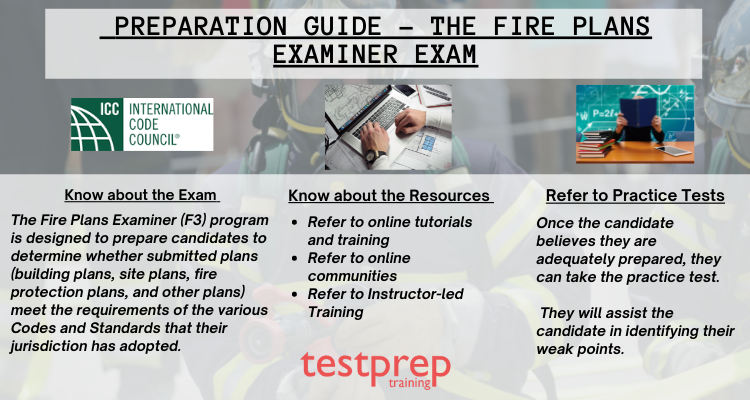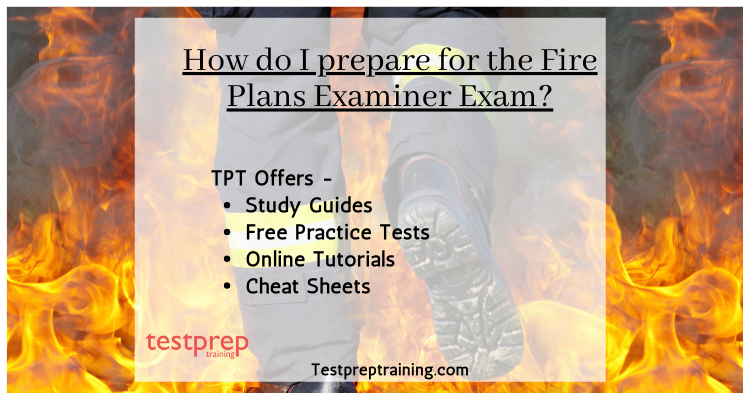Building inspectors plan examiners, and building officials must be ICC certified. Certifications show that the inspector or plans examiner has been properly trained in their field of expertise and can apply the code to construction projects effectively. Passing an International Code Council (ICC) certification exam is required to become a certified fire plans examiner. Let us look at the preparation guide for the Fire Plans Examiner Exam!
About Fire Plans Examiner Exam
The Fire Plans Examiner (F3) program is designed to prepare candidates to determine whether submitted plans (building plans, site plans, fire protection plans, and other plans) meet the requirements of the various Codes and Standards that their jurisdiction has adopted. This certification will assist you in furthering your career.
Furthermore, once you have completed this certification, you will be able to review and approve submitted plans for life safety and fire issues such as interior finish, occupancy type, height and area limitations, construction type, and general fire safety.
How to qualify for the Fire Plans Examiner Exam?
To begin, you should familiarise yourself with all of the topics and subtopics covered in the Fire Plans Examiner Exam syllabus. This will help you understand what you’ll need to learn and how you’ll organize your study time. Also, to pass the exam, follow these steps:
1. Know about the Exam Syllabus
This initial step is very important to get a complete idea about the exam –
Administration: 5%
Research and Testimony: 2%
- Research fire protection requirements for special construction, operations, and materials. When directed by the fire code official, provide expert technical testimony on fire codes and standards.
Consultation and Explanation: 2%
- Assist in coordinating the activities of the fire code official with the building official, zoning official, registered design professional, owner/developer, contractor, and public utilities.
Recordkeeping: 1%
- Prepare and maintain a record of each fire protection plans examination that is conducted, including notices and orders issued, showing the findings and disposition of each.
Occupancy: 15%
Occupancy Type: 2%
- Verify that the occupancy type of the building is correct.
Type of Construction: 3%
- moreover, Verify that the specified type of construction of the building is correct.
Occupant Load: 4%
- furthermore, Verify code compliance of the specified occupant load for individual rooms.
Specific Occupancy and Use Hazards: 3%
- moreover, Verify code compliance to protect against hazards of specific occupancies and use.
Evaluate Special Fire Protection Features: 3%
- Verify that special fire protection features, such as fire-resistive materials and surface treatments, and clearance of combustibles surrounding the building are specified where required.
Hazardous Materials: 20%
Management Plan: 2%
- also, Review the hazardous materials management plan and inventory statement for compliance with code requirements for the prevention, control, and mitigation of dangerous conditions related to storage, dispensing use, and handling of hazardous materials.
Material Safety Data Sheets: 2%
- furthermore, Verify that material safety data sheets are submitted on hazardous materials, and specify the material classification hazard. Verify correct classification of hazardous materials and maximum allowable quantity.
Control Areas: 3%
- Verify that control areas are specified where required, and are designed and constructed following the code.
Special Hazards: 3%
- Verify that occupancies with special hazards, such as hazardous production material (HPM), semiconductor fabrication, dry cleaning, and woodworking, comply with specific code requirements for these hazards. Verify that explosion control is provided where required.
Flammable and Combustible Liquids and Gases: 5%
- also, Verify that storage, use, and handling of flammable and combustible liquids and gases are specified and comply with special code requirements.
Storage of Combustibles: 5%
- furthermore, Verify the general fire protection and safety requirements for combustible storage.
Fire Protection: 35%
Water Supply for Fire Protection: 5%
Sprinklers, Standpipes, and Alternate Automatic Fire Extinguishing Systems: 12%
- also, Verify that sprinklers, standpipes, and alternate automatic fire extinguishing systems are specified where required; Verify compliance with construction and equipment specifications for layout, installation, operation, and monitoring.
Fire Alarm and Detection Systems: 11%
- furthermore, Review that fire alarm and detection systems are specified where required, are designed by qualified persons to the appropriate standard, are designed for the specified class of service, and are listed for their specified use. Verify compliance with construction and equipment specifications for layout, installation, operation, and monitoring.
Portable Extinguishers: 2%
- moreover, Verify compliance of size, class, and location of portable extinguishers.
Smoke Control Systems: 5%
- also, Verify that mechanical and passive smoke control systems are specified where required and are designed by qualified persons to the appropriate standards.
Egress Safety: 25%
Emergency and Standby Power: 2%
- Verify that emergency and standby power is provided for systems egress and occupant safety, and are listed for the specified use.
Egress Doors: 6%
- also, Verify that egress doors are provided where required, are of adequate size, swing, fire protection rating, and compliance with panic or fire exit hardware.
Stairs, Ramps, and Balconies: 6%
- furthermore, Verify that stairs, ramps, and balconies comply with code requirements, including rising/run of steps, width, length, guards, rails, and landings.
Exit Access: 7%
- moreover, Verify that the egress route complies with code requirements for width, clearances, maximum travel distance, fire protection, illumination, and signage. Verify that any dead-end corridors comply with code requirements.
Access to Buildings, Windows, and Roofs: 2%
- also, Verify that the building and its windows and roof are accessible for emergency access by the fire department.
Hazards to Fire Fighters: 2%
- furthermore, Verify that posting of signage for hazardous materials is specified on the plans where required.

2. Know about the Exam Format
This improves retention of updates and, as a result, provides a clear vision of how to proceed with the preparation based on the type of questions asked and the time duration.
The examination, Fire Plans Examiner (F3) having exam ID F3 is an open book examination. Furthermore, for Fire Plans Examiner (F3) exam questions, there will be a total of 60 questions that have to be completed in a total time of 3 hours 30 minutes. You need to keep in mind that you need to manage your time accordingly for your best performance. This examination will cost you $219.
3. Is a Fire Plans Examiner a good career to explore?
Fire inspectors work in both offices and out in the field. Inspectors inspect buildings such as apartment complexes and offices in the field and other structures, such as arenas and industrial plants. Fire investigators go to a fire scene. They may have poor ventilation, smoke, fumes, and other potentially hazardous substances. Forest fire inspectors and prevention specialists spend a lot of time outside, assessing the risks of fires in places like forests, fields, and other natural or outdoor settings.
Fire inspectors and investigators earn a median annual salary of $64,610. The median wage is the wage at which half of the workers in a given occupation earned more and half earned less. The lowest 10% earned less than $39,860, while the highest 10% earned more than $100,780.
4. Refer to the Learning Resources
It is critical to plan ahead of time with the appropriate resources. To pass any examination, you must work hard but efficiently and intelligently. You can also prepare for the exam by enrolling in online training programs.
- ICC provides virtual training in which you can communicate with the instructor remotely.
- In addition, they offer live webinars for topic-based training as well as recorded online training that you can access from anywhere and at any time to learn about topics of interest.
Start Practicing with Testpreptraining
A man becomes perfect through practice. Practice will assist you in identifying the aspects of your preparation that require improvement. Following the completion of your preparation, you should be taking sample papers and practice tests. Fire Plans Examiner (F3) practice tests will assist you in self-assessment and will make you feel more confident on the day of the exam. The evolution of practice tests has only increased its generosity. They are one of the most effective means of preparing for the exam. Begin using Fire Plans Examiner (F3) Sample Questions right away!

